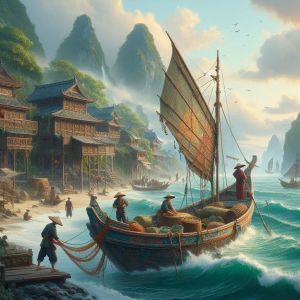Igochians

The Igochians, or as they call themselves, the Ryusei-no Hami, meaning "people of the sun" in the common tongue, are a noble and honorable subrace of humans. They originate from the eastern continent of Igochi. Though it is not unusual to see Igochians in other, far-away lands, the majority of their people are still deeply rooted in their continent of origin.
Igochians hail from a land of rolling steppes, majestic mountains, and serene coastal villages, each region contributing uniquely to the Igochian identity and diversity. The Igochians are a people of contrasts—warriors and poets, farmers and scholars, united by a common heritage, their desire to attain perfection in every aspect of their lives, and an unyielding spirit.
Description
Igochians, on average, are similar in size to other humans, though they tend to be slightly shorter. Women in particular often exhibit a leaner physique. Their skin tones span from light brown to pale white, reflecting the diverse environments of their homeland.
The Igochians predominantly have hair that is either black or dark brown, colors as deep and rich as the ink used in their traditional calligraphy. A rare few are born with white hair, a trait that is seen as a divine blessing, marking them as individuals touched by the heavens. This distinctive feature often brings reverence and respect from their peers.
Their eyes are usually dark brown, like the fertile soil of their homeland, but it is not uncommon to find Igochians with lighter brown, grey, or even the rare and mystical purple eyes. These unique eye colors are often celebrated, thought to signify inner strength and wisdom.
Society

Igochian societies are shaped profoundly by two factors: the surrounding environment and social status.
The varied terrains and environments of Igochi have created a rich and diverse society. The type of land where a particular community exists greatly influences the activities its people pursue and their way of life. It is common for Igochians to form communities around specific activities, such as farming, fishing, or trade. The surrounding environment dictates not only their livelihoods but also their cultural practices and daily routines.
Social status plays a significant role in the daily life of an Igochian. Class barriers between nobles and commoners are distinctly marked, influencing where people live and how they interact. Commoners typically reside in small settlements or on the outskirts of major city centers. They lead simple lives, dedicating themselves to their trades and crafts, fostering a strong sense of community and mutual support.
Nobles, on the other hand, favor the centers of large cities, enjoying more luxurious lifestyles. These urban areas are hubs of culture and power, where noble families often reside in grand homes. Some nobles are esteemed warriors, while others devote themselves to artistic or scholarly pursuits, contributing to the cultural and intellectual wealth of Igochi.
Architecturally, Igochian constructions are relatively simple but exhibit an extreme attention to detail. This meticulous craftsmanship is evident even in common buildings, reflecting the Igochian dedication to perfection. Larger structures, such as palaces and temples, are marvels of architecture and artistic expression, showcasing the society's aesthetic values and engineering prowess. These grand buildings stand as symbols of Igochian heritage, embodying their cultural pride and artistic achievements.
Economy

The Igochian economy is as diverse and vibrant as its landscapes, intricately woven from the varied resources and skills of its people. In the fertile regions of Igochi, lush fields of rice and tea stretch across the land, providing sustenance and trade goods. These farming communities form the backbone of the economy, their diligent efforts ensuring a steady supply of food and raw materials.
Along the serene coastlines, villages thrive on fishing and trade. The Igochians, skilled sailors, navigate their well-crafted vessels through bustling ports that serve as the lifeblood of commerce. Here, the exchange of goods with distant regions brings a wealth of exotic items and materials, enriching the local economy and fostering cultural exchange.
Known far and wide for their exceptional craftsmanship, Igochian artisans produce goods of unparalleled quality. Silks woven with intricate patterns and vibrant colors are highly prized, their delicate texture and stunning designs sought after by nobles and merchants alike. Jade jewelry, meticulously carved and polished, stands as a testament to their mastery of this precious stone, with pieces that range from elegant ornaments to elaborate ceremonial artifacts. Pottery, crafted with a keen eye for detail and aesthetic beauty, showcases the artistry of the Igochians, each piece a unique blend of functionality and art. These artisans are held in high regard, their work vital to the economic and cultural fabric of society.
In the heart of cities and towns, vibrant marketplaces buzz with activity. Merchants, their stalls brimming with a variety of goods, engage in lively trade. From fresh produce to rare imports, these markets are hubs of economic activity and social interaction, where deals are made and news is exchanged.
The patronage of nobles further stimulates economic and cultural growth. These affluent individuals sponsor artisans and scholars, commissioning works of art and funding research. This support not only enriches Igochian culture but also drives innovation and excellence in various fields.
Guilds play a crucial role in regulating trade and craft industries. Ensuring high standards and fair practices, these organizations provide support and training for their members. Guild halls are centers of community and professionalism, where knowledge is shared and traditions are upheld.
Overall, the Igochian economy thrives on a foundation of agriculture, trade, craftsmanship, and noble patronage, creating a dynamic and prosperous society.